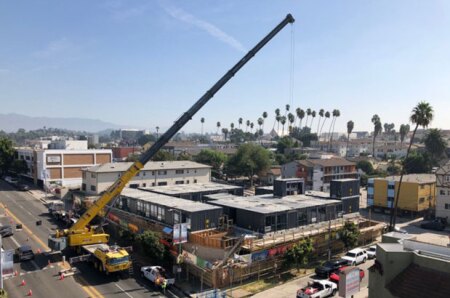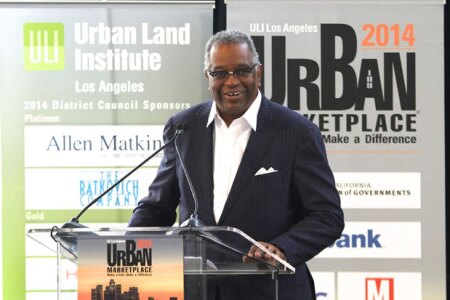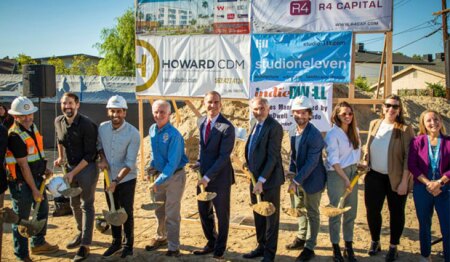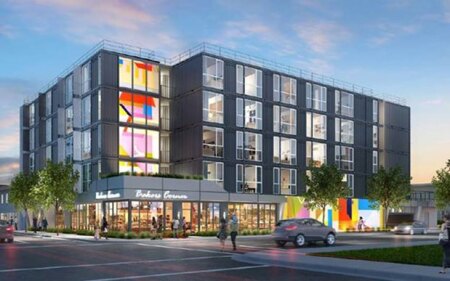On March 29, ULI Los Angeles will host Urban Marketplace 2022: Advancing Equity Through Infrastructure, as it continues celebrating the event’s 22nd anniversary. Founded by Michael Banner, president and CEO of Los Angeles LDC, and other leaders of ULI Los Angeles in 2000, Urban Marketplace soon became the district council’s signature annual event, with a focus on underserved and underinvested communities.
The event features a dynamic format including “roundtable” discussions that offer direct access to decision-makers. Representatives of the public sector (i.e., transportation, housing, and so forth), the design and planning community, community advocates, small business owners, neighborhood-focused developers, and others all interact with each other and attendees so that ideas and connections ignite.
The event motto—“make a deal, make a difference,” coined by commercial broker and poet Ed Rosenthal at the 2000 inaugural Urban Marketplace—expresses this mission. And “make a deal, make a difference” has been the event’s rallying cry ever since. Leaders gathered at this event not only have the means to improve communities of color and lower income, they also bring their vision and sense of responsibility in the crucial realm of housing.
Banner—who is a past ULI Los Angeles chair—explains how evaluating the housing needs of underserved communities requires careful attention to gentrification and community-based growth.
“As housing scarcity grows, less commercially desirable neighborhoods become financially attractive to affluent renters,” he says. “The market then catches the attention of investors and developers, spurring surges in rents and displacement that further harms residents and smaller business owners. Urban Marketplace makes sure ULI is at the table to deliver changes, even in homeownership,” Banner says. “The effect of the event can now be seen in Los Angeles neighborhoods such as downtown and in cities such as Inglewood.”
Gentrification and Displacement
Urban Marketplace was designed to flip displacement on its head and bring attention to flourishing economic opportunities before the flood of gentrification. In contrast, many infrastructure investments affect housing negatively, Banner says, as evidenced by freeway projects that often tear homes down and displace communities.
“The Santa Monica freeway was a massive infrastructure project that destroyed the successful black community of Sugar Hill by displacing residents,” Banner says. “Yes, in the past 10 years, the West Adams community south of the freeway has seen a revival, but it’s not the people who had lived there for generations. As with so many others, those people were displaced.”
The 2022 Urban Marketplace will focus on infusing equity in new infrastructure investments. Banner stresses, “Infrastructure projects will have catalytic value, but we have to implement them in a way that doesn’t harm communities.”
At its 22th anniversary, the Urban Marketplace goal was more urgent than ever. ULI leaders adopted the theme “Advancing Equity Through Infrastructure.” The event not only showed how to leverage new infrastructure (including major investment coming from Washington, DC), it addressed previous mistakes. As Banner noted, all too often projects such as transportation and urban redevelopment have injured already handicapped neighborhoods—dividing them, extracting wealth or causing displacement of residents and grass-roots businesses.
“Infrastructure is one of the most powerful and necessary tools for revitalizing struggling neighborhoods. And yet, past projects have caused harm to communities through infrastructure investments and overlooked the harm and long-term impacts to these communities,” says Urban Marketplace Chair and Ashurst counsel Shmel C. Graham.
Focus on Housing
There is perhaps no more pervasive a category of infrastructure than housing. California already suffered a severe housing crisis prior to COVID-19. Citing data from the 2020 Census, Public Policy Institute of California calculated that “the state added 3.2 times more people than housing units over the last 10 years. There are now 2.93 Californians for every occupied housing unit, behind only Utah (3.09) and Hawaii (2.93), and far above the average of all other states (2.53).” And the pandemic’s economic devastation multiplied the number of unhoused and food-insecure in cities such as Los Angeles.
Urban Marketplace 2022 devoted several roundtables to the issue. In “Development Without Displacement,” Studio One Eleven senior studio director of urban design Shannon Heffernan discussed enlightened planning for new transit development. The Long Beach-based architecture, landscaping, and urban design firm commits itself to equitable practice, rejecting any projects that directly displace existing residents. It has joined in guiding development resulting from the West Santa Ana Branch Transit Corridor Project. Spanning 19.3 miles, the new light rail project will include 12 stations in southern cities of Los Angeles County: high-density communities suffering from limited mobility and transit options.
The goal is to help ensure that the new transportation investment does not uproot legacy businesses or displace residents. The housing component is especially critical, says Heffernan.
“There is a rare opportunity here to uplift the communities along the West Santa Ana Branch Line with the development of all types of housing—affordable, supportive, middle-income, and market-rate homes, along with homeownership options, which are also greatly needed,” she says. “An incremental approach to development in these station areas on appropriate infill sites ensures that legacy businesses remain intact while retaining and adding housing for existing and future residents. Housing and development can be integrated into these station areas in a meaningful way through an equitable approach. And this was echoed by the many residents we spoke with in developing our Station Area Plans.”
Heffernan joined public- and private-sector officials and community groups in the below approaches toward equitability:
- The Pacific/Randolph and Florence/Salt Lake Station Area Plans were a collaborative process resulting from many hours of canvasing and conversations with residents, business owners, and employees in Huntington Park, Bell, Cudahy, and Maywood, as well as input from city staff and elected officials.
- Through this process the community identified legacy businesses and street culture to maintain, as well as the types of development—both housing and destination-focused—that they would like to see in each station area.
- Studio One Eleven created “What If” development scenarios to explore a comprehensive vision and identified potential sites for development and densification for each station area. Teams were thoughtful in selecting underutilized properties that did not include existing residential uses or legacy businesses as identified by the community.
- The ‘what if’ scenario included development prototypes that would enable a greater variety of housing options for the community close to the proposed stations while also activating major corridors with ground-floor retail and restaurant opportunities.
- The many development prototypes demonstrate developments that can serve as a gateway moment into the downtown or compact urban infill projects, and how to take advantage of narrow corridor sites with a townhomes prototype to provide opportunities for homeownership.
- Land use and zoning recommendations facilitate this transit-supportive development on infill sites in each station area.
- Station area plans are unique in that they include strategies for how to make new development equitable to meet the needs of both existing and future residents. These recommended policy and program tools include additional green and open spaces.
- Document recommendations will be in Spanish to expand its reach to the communities and residents along the West Santa Ana Branch Corridor.
Current housing designs by Studio One Eleven are similarly focused. A new network of supportive housing (providing homes and services to the chronically unhoused), includes partnerships with
Daylight Community Development in distressed communities such as parts of Watts, North Hollywood, and the San Fernando Valley.
Replicating Housing Quickly
Also at Urban Marketplace 2022 were roundtables such as “Replicating Supportive Housing Efficiently and Humanely,” and “Accelerated Equity Home Ownership & Transit-Oriented Development.”
In the supportive housing discussions, KTGY associate principal Mark Oberholzer offered advances in designing and developing modular solutions. The replicability of modular construction targets multiple issues of social infrastructure: affordability, housing the unhoused, revitalizing neighborhoods, and preserving energy and resources. KTGY and its development partners are building a network of such housing across Los Angeles County, with one project complete and occupied, three under construction, and several more deep in the planning stage.
“This new construction type—with its related cost savings and overall efficiency—is expected to lead future projects built at much lower costs and on quicker timelines to meet the urgent need for supportive housing,” says Oberholzer. The specifics of this construction type include: highly replicable design using steel modules; deliverable speed and scale required by neighborhoods in need; and modules manufactured off-site, incorporating customized interiors and fittings.
All of the supportive housing in this series include on-site services to help residents return to stable living situations. Development partners include HBG Construction Corp, Aedis Real Estate Group, and BRIDGE Housing Corp.
It is important, Oberholzer stresses, that all these developments offer humane and stimulating living conditions. In addition to the support services, amenities include landscaped courtyards and breezeways, secure meditative spaces and rooftop decks for privacy, safety, and comfort.
Partnering with developer American Family Housing, KTGY recently created 71 affordable housing units, plus community rooms and services, surrounded by courtyards, plazas, and landscaping. The modular design employs wood-modular construction—built offsite and assembled complete with fixtures and finishes for efficiency in cost and construction time.
Casa Paloma is also the first supportive housing community in Orange County to integrate on-site health services for its residents, in a first-ever partnership of its kind with CalOptima, the county’s Medi-Cal provider.
Oberholzer addressed other solutions coming to California, including housing that serves at-risk youth, another missing piece of the infrastructure puzzle. Villa Fruitvale in Oakland is a multifamily development focused on at-risk youth with up to 40 percent average median income (AMI). The youth units accommodate single youth and those who are custodial parents. The development also targets the local workforce up to 60 percent AMI. These modular-construction apartments have an estimated completion of 2024. Villa Fruitvale, co-owned and developed by The John Stewart Company, will be operated by Covenant House, which provides housing and supportive services to youth facing homelessness.
VIOLET FLOCKS chairs ULI Los Angeles’ Communications Committee and is a J.D. candidate at Loyola Law School.








